1 . A company is developing an Internet store for its website. Which protocol should be used to transfer credit card information from customers to the company web server?
• FTPS
• HTTP
• HTTPS
• WEP2
• TFTP
Q.2. 
Refer to the exhibit. A new branch office has been added to the corporate network and a new router is to be installed to allow branch office users to access the database server at headquarters. How should the serial 0/0/0 interface of the new branch office router be configured to connect to the headquarters router?
• branch_23(config-if)# ip address 192.168.5.19 255.255.255.240
branch_23(config-if)# no shutdown
• branch_23(config-if)# encapsulation hdlc
branch_23(config-if)# ip address 192.168.5.25 255.255.255.240
branch_23(config-if)# no shutdown
• branch_23(config-if)# encapsulation ppp
branch_23(config-if)# no shutdown
• branch_23(config-if)# encapsulation ppp
branch_23(config-if)# ip address 192.168.5.33 255.255.255.240
• branch_23(config-if)# encapsulation ppp
branch_23(config-if)# ip address 192.168.5.21 255.255.255.240
branch_23(config-if)# no shutdown
Q.3. Which two commands ensure that any password that permits access to the privileged EXEC mode is not shown in plain text when the configuration files are displayed? (Choose two.)
• Router(config)# enable secret cisco
• Router(config)# enable cisco
• Router(config)# encryption-password all
• Router(config)# enable login encrypted
• Router(config)# enable password encryption
• Router(config)# service password-encryption
Q.4. A new network is to be configured on a router. Which of the following tasks must be completed to configure this interface and implement dynamic IP routing for the new network? (Choose three.)
• Select the routing protocol to be configured.
• Assign an IP address and subnet mask to the interface
• Update the ip host configuration information with the device name and new interface IP address.
• Configure the routing protocol with the new network IP address.
• Configure the routing protocol with the new interface IP address and subnet mask.
• Configure the routing protocol in use on all other enterprise routers with the new network information.
Q.5. How does TCP ensure the reliable transfer of data?
• if data segments are not received from the source, the destination requests that the segments be resent.
• If an acknowledgment of the transmitted segments is not received from the destination in a predetermined amount of the time, the source resends the data. • TCP uses the SYN-ACK portion of the three-way handshake to ensure that all data has been received.
• The TCP Protocol Interpreter process verifies the transmitted data at source and destination.
Q.6. A network administrator is asked to design a system to allow simultaneous access to the Internet for 250 users. The ISP for this network can only supply five public IPs. What can be used to accomplish this task?
• routable translation
• dynamic translation
• static translation
• port address translation
Q.7. What is the most commonly used exterior routing protocol?
• BGP
• RIP
• OSPF
• EIGRP
Q.8. 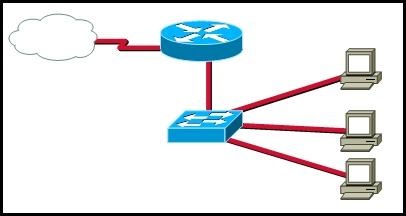
Refer to the exhibit. The network administrator needs to configure the router with a name. Which command will the administrator use to configure the router name?
• Router# ip hostname Boise
• Router# enable hostname Boise
• Router(config-line)# name Boise
• Router(config)# hostname Boise
• Router(config)# ip hostname Boise
Q.9. Why are port numbers included in the TCP header of a segment?
• to indicate the correct router interface that should be used to forward a segment
• to identify which switch ports should receive or forward the segment
• to determine which Layer 3 protocol should be used to encapsulate the data
• to enable a receiving host to forward the data to the appropriate application
• to allow the receiving host to assemble the packet in the proper order
Q.10. What is the purpose of the routing process?
• to encapsulate data that is used to communicate across a network
• to select the paths that are used to direct traffic to destination networks
• to convert a URL name into an IP address
• to provide secure Internet file transfer
• to forward traffic on the basis of MAC addresses
Q.11. Which two statements are true about the use of the debug ip rip command on a Cisco router? (Choose two.)
• The debug ip rip command displays RIP routing activity in real time.
• The debug ip rip command can be issued at the user EXEC configuration mode.
• The debug ip rip command displays a combination of the information that is displayed by the show ip route and show ip protocols commands.
• Because of router processor usage, the debug ip rip command should be used only when necessary.
• The debug ip rip command should be used instead of the show ip route command whenever possible.
Q.12. What minimum configurations must be set on a host to allow a request to be sent to http://www.cisco.com/? (Choose four.)
• DNS server
• WINS server
• IP address
• NetBIOS
• subnet mask
• default gateway
Q.13. A Catalyst 2960 switch has been taken out of storage to be used as a temporary replacement for another switch that needs to be repaired. About a minute after the switch has started, the SYST LED on the front of the switch transitions from blinking green to amber. What is the meaning of the amber SYST LED?
• The switch has no configuration file in NVRAM.
• The switch has failed POST and must be sent for service.
• The switch is functioning properly.
• The switch is in half-duplex mode.
Q.14. 
Refer to the exhibit. Which combination of cables and symbols is correct?
• A - crossover, B - straight-through, C - straight-through
• A - crossover, B - rollover, C - straight-through
• A - straight-through, B -crossover, C - straight-through
• A - straight-through, B -straight-through, C - straight-through
• A - straight-through, B - straight-through, C - crossover
• A - rollover, B - straight-through, C - straight-through
Q.15. After an unsuccessful ping to the local router, the technician decides to investigate the router. The technician observes that the lights and fan on the router are not operational. In which layer of the OSI model is the problem most likely occurring?
• transport
• network
• data link
• physical
Q.16. What are three characteristics of the TCP protocol? (Choose three.)
• exchanges datagrams unreliably
• is used to send IP error messages
• forces the retransmission of unacknowledged packets
• creates a virtual session between end-user applications
• carries the IP address of the destination host in the TCP header
• is responsible for breaking messages into segments and reassembling them at their destination
Q.17.  Refer to the exhibit. The network shown is connected using services from the same ISP. How will the Fohi router dynamically learn routes to the 192.168.16.16/28, 192.168.16.32/28, and 192.168.16.64/28 subnetworks?
Refer to the exhibit. The network shown is connected using services from the same ISP. How will the Fohi router dynamically learn routes to the 192.168.16.16/28, 192.168.16.32/28, and 192.168.16.64/28 subnetworks?
• with BGP
• with a static route
• with a directly connected route
• with an interior routing protocol
Q.18. 
Refer to the exhibit. Which type of UTP cable should be used to connect Host A to Switch1?
• rollover
• console
• crossover
• straight-through
Q.19When customers use credit cards to make purchases at a small business, a modem is heard dialing a telephone number to transfer the transaction data to the central office. What type of WAN serial connection is in use?
• leased line
• packet switched
• circuit switched
• point-to-point
Q.20. A user reports being unable to access the Internet. The help desk technician employs a bottom-up approach to troubleshooting. The technician first has the user check the patch cable connection from the PC to the wall, and then has the user verify that the NIC has a green link light. What will the technician have the user do next?
• Enter an IP address into the WWW browser address bar to see if DNS is at fault.
• Use traceroute to identify the device along the path to the ISP that may be at fault.
• Verify the IP address, subnet, and gateway settings using ipconfig on the PC .
• Connect to the user home router to check firewall settings for blocked TCP ports.
Q.21. 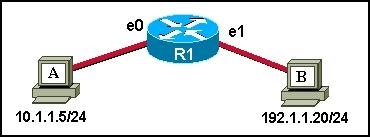
A ping 192.1.1.20 command is issued on workstation A to determine if workstation B can be reached. What events will occur if this command is successful? (Choose two.)
• The router will block the ping request message.
• The router will reply to the echo request with a proxy ping response.
• Workstation A will send a UDP ping request message to workstation B.
• Workstation B will send a UDP ping reply message to workstation A.
• Workstation A will send an ICMP echo request message to workstation B.
• Workstation B will send an ICMP echo reply message to workstation A.
Q.22. How does a router know of paths to destination networks? (Choose two.)
• inspection of the destination IP address in data packets
• ARP requests from connected routers
• manual configuration of routes
• updates from other routers
• DHCP information broadcasts
• updates from the SMTP management information base
Q.23. 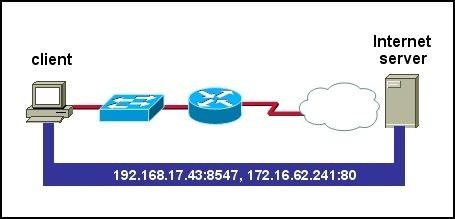
Refer to the exhibit. Which two statements describe the data conversation shown? (Choose two.)
• The data conversation was started by the HTTP application process running on the client.
• The data conversation is identified by TCP port 80 on the client.
• The user started the data conversation by sending an e-mail.
• The IP address of the Internet server is 192.168.17.43 .
• The Internet server will send data to port 8547 on the client.
Q.24. What is one purpose of the TCP three-way handshake?
• sending echo requests from the source to the destination host to establish the presence of the destination
• determining the IP address of the destination host in preparation for data transfer
• requesting the destination to transfer a binary file to the source
• synchronizing sequence numbers between source and destination in preparation for data transfer
Q.25. Which type of address is 192.168.17.111/28?
• host address
• network address
• broadcast address
• multicast address
Q.26. A customer reports connectivity problems to an ISP technician. Upon questioning the customer, the technician discovers that all network applications are functioning except for FTP. What should the technician suspect is the problem?
• misconfigured firewall
• bad port on switch or hub
• misconfigured IP addressing on the customer's workstation
• wrong DNS server configured on the customer's workstation
• wrong default gateway configured on the customer's workstation
Q.27. 
The show ip route command was executed on one of the routers shown in the graphic and the following output was displayed:
C 192.168.4.0/24 is directly connected, Serial0/0
R 192.168.5.0/24 [120/1] via 192.168.4.2, 00:00:19, Serial0/0
R 192.168.1.0/24 [120/2] via 192.168.3.1, 00:00:20, Serial0/1
R 192.168.2.0/24 [120/2] via 192.168.3.1, 00:00:20, Serial0/1
C 192.168.3.0/24 is directly connected, Serial0/1
From which router was this command executed?
• A
• B
• C
• D
Q.28. Refer to the exhibit. Which two sets of commands are required to configure passwords for all management ports on a Catalyst 2960 switch? (Choose two.)
• ALSwitch(config)# interface vlan 1
ALSwitch(config-if)# password cisco
ALSwitch(config-if)# login
• ALSwitch(config)# line vty 0 4
ALSwitch(config-line)# password cisco
ALSwitch(config-line)# login
• ALSwitch(config)# line vty 0 15
ALSwitch(config-line)# password cisco
ALSwitch(config-line)# login
• ALSwitch(config)# enable secret class
ALSwitch(config)# enable password cisco
• ALSwitch(config)# interface fa0/1
ALSwitch(config-if)# password cisco
ALSwitch(config-if)# no shutdown
• ALSwitch(config)# line cons 0
ALSwitch(config-line)# password cisco
ALSwitch(config-line)# login
Q.29. A user reports being able to access the Internet but not being able to download e-mail from the mail server at the ISP. What should the user check on the user workstation?
• the POP3 and SMTP server settings in the e-mail application
• the patch cable connections at the back of the workstation and at the wall plate
• the DHCP settings in the operating system
• the IP address, mask, and default gateway values
• the NIC drivers
Q.30. 
Refer to the graphic. Which command will configure a static route on Router A to direct traffic from LAN A that is destined for LAN C?
• RouterA(config)# ip route 192.168.4.0 255.255.255.0 192.168.5.2
• RouterA(config)# ip route 192.168.4.0 255.255.255.0 192.168.3.2
• RouterA(config)# ip route 192.168.5.0 255.255.255.0 192.168.3.2
• RouterA(config)# ip route 192.168.3.0 255.255.255.0 192.168.3.1
• RouterA(config)# ip route 192.168.3.2 255.255.255.0 192.168.4.0
Q.31. Which subnet masks could be used when subnetting a Class B IP address? (Choose two.)
• 255.255.255.240
• 255.255.192.0
• 255.255.0.0
• 255.192.0.0
• 240.0.0.0
• 255.0.0.0
Q.32. 
Refer to the exhibit. The network administrator has configured the RTA and RTB interfaces. In order to allow hosts that are attached to RTA to reach the server that is attached to RTB, a static route from RTA to the server LAN and a default route from RTB back to RTA need to be configured. Which two commands will the administrator use to accomplish these tasks on the two routers? (Choose two.)
• RTA(config)# ip route 10.16.10.5 255.255.255.252 10.16.10.6
• RTA(config)# ip route 0.0.0.0 0.0.0.0 10.16.10.6
• RTA(config)# ip route 10.16.10.96 255.255.255.252 10.16.10.6
• RTB(config)# ip route 10.16.10.6 255.255.255.248 10.16.10.6
• RTB(config)# ip route 0.0.0.0 0.0.0.0 S0/0/1
• RTB(config)# ip route 0.0.0.0 0.0.0.0 10.16.10.6
Q.33. How do port filtering and access lists help provide network security?
• They prevent specified types of traffic from reaching specified network destinations.
• They alert network administrators to various type of denial of service attacks as they occur.
• They prevent viruses, worms, and Trojans from infecting host computers and servers.
• They enable encryption and authentication of confidential data communications.
Q.34. 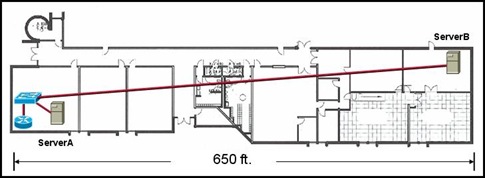
Refer to the exhibit. The network administrator of the building in the graphic needs to choose the type of cable best suited to add ServerB to the network. Which cable type is the best choice?
• STP
• UTP
• coaxial
• fiber optic
Q.35. What is used by a routing protocol to determine the best path to include in the routing table?
• Convergence time
• Default distance
• Metric
• Type of router
Q.36. 
Refer to the exhibit. Which IP addresses could be assigned to the hosts in the diagram? (Choose two.)
• 192.168.65.31
• 192.168.65.32
• 192.168.65.35
• 192.168.65.60
• 192.168.65.63
• 192.168.65.64
Q.37. 
Given the network 192.168.25.0 shown in the graphic, which subnet mask would accommodate the number of hosts in each subnet?
• 255.255.0.0
• 255.255.224.0
• 255.255.255.0
• 255.255.255.224
• 255.255.255.240
• 255.255.255.248
Q.38. Which two protocols allow network devices to report their status and events to a centralized network management device? (Choose two.)
• Syslog
• Telnet
• HTTP
• HTTPS
• SNMP
Q.39. What is true regarding the differences between NAT and PAT?
• PAT uses the word "overload" at the end of the access-list statement to share a single registered address.
• Static NAT allows an unregistered address to map to multiple registered addresses.
• Dynamic NAT allows hosts to receive the same global address each time external access is required.
• PAT uses unique source port numbers to distinguish between translations.
Q.40. 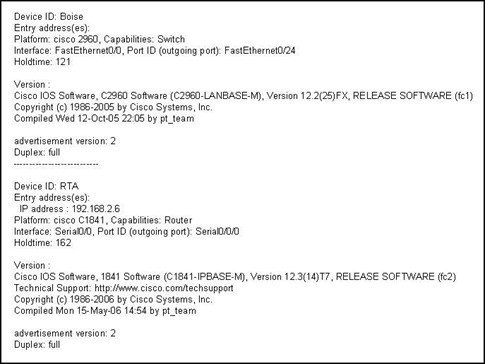
Refer to the exhibit. The graphic shows the output of a command issued on router RTB. According to the output, what two statements are true of router RTB? (Choose two.)
• The router is connected to a router named Boise.
• Router RTB is connected to a Cisco 1841 router.
• Router RTB is directly connected to two other routers.
• The IP address of the router interface connected to router RTB is 192.168.2.6 .
• The RTB router is connected to two Cisco devices by Fast Ethernet links.
Q.41. 
Refer to the exhibit. The network administrator uses the command below to configure a default route to the ISP network : RTB(config)# ip route 0.0.0.0 0.0.0.0 10.1.1.6 A ping issued from the ISP is successful to router RTB. However, ping echo request packets arrive at a host that is attached to the Fa0/0 interface of RTB, and the replies do not make it back to the ISP router. What will fix this problem?
• The ISP must be configured to forward packets from the 192.168.1.0 network.
• The ip route command needs to be edited so that the next hop address is 10.1.1.5.
• The ip route command needs to be edited so that the 192.168.1.1 address is the next hop address.
• The ip route command should be removed from the RTB router configuration.
Q.42. A network technician is using a network management station to gather data about the performance of devices and links within the ISP. Which application layer protocol makes this possible?
• SNMP
• FTP
• DHCP
• SMTP
Q.43. What are two purposes of DNS? (Choose two.)
• to dynamically assign IP addressing information to network hosts
• to simplify the administration of host and default gateway addressing on client computers
• to assign TCP port numbers to hosts as part of the data transfer process
• to resolve human-readable domain names to numeric IP addresses
• to replace the static HOSTS file with a more practical dynamic system
Q.44. A hacker attempts to reach confidential information that is stored on a server inside the corporate network. A network security solution inspects the entire packet, determines that it is a threat, and blocks the packet from entering the inside network. Which security measure protected the network?
• an IDS
• an IPS
• a host-based firewall
• Anti-X software
Q.45. How many host addresses may be assigned on each subnetwork when using the 130.68.0.0 network address with a subnet mask of 255.255.248.0?
• 30
• 256
• 2046
• 2048
• 4094
• 4096
Q.46. In an IPv4 environment, what information is used by the router to forward data packets from one interface of a router to another?
• destination network address
• source network address
• source MAC address
• well known port destination address
Q.47. A small tire retailer requires a low-cost WAN connection to its headquarters in order to manage its inventory and process customer sales in real time. Which WAN connection type is best suited to its needs?
• Sonet
• T3
• dialup
• DSL
• leased line
Q.48. The command copy tftp running-config has been entered on the router. What will this command do?
• copy the configuration in RAM to a server
• copy the configuration file from a server to RAM
• copy the configuration file in NVRAM to RAM
• copy the configuration file in NVRAM to a server
• copy the configuration file from a server to NVRAM
Q.49. 
Refer to the exhibit. The network administrator needs to configure the Fa0/0 interface of RTB so that hosts from RTA can connect to the server that is attached to RTB. Which two commands will the administrator use to accomplish this task? (Choose two.)
• RTB# ip address 192.168.102.98 255.255.255.248
• RTB(config-if)# ip address 192.168.102.99 255.255.255.252
• RTB(config)# ip address 192.168.102.97 255.255.255.252
• RTB(config)# no shutdown
• RTB(config-if)# no shutdown
• RTB(config-if)# ip address 192.168.102.97 255.255.255.252
Q.50. 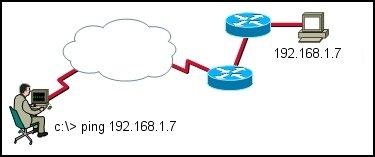
Refer to the exhibit. A NOC technician at an ISP enters the command shown. What are two reasons to use this command? (Choose two.)
• to map the path to 192.168.1.7
• to test reachability to 192.168.1.7
• to locate connectivity problems along the route to 192.168.1.7
• to identify the ISPs that interconnect the NOC with the remote host with the address 192.168.1.7
• to measure the time that packets take to reach 192.168.1.7 and return to the technician's workstation
TimE
Labels
- CCNA Discovery 1 Version 4 Networking for Home and Small Businesses (9)
- CCNA Discovery 2 : Working at a Small-to-Medium Business or ISP (9)
- CCNA Discovery 3 : Introducing Routing and Switching in the Enterprise (10)
- CCNA Discovery 4 : Designing and Supporting Computer Networks (Version 4.0) (9)
- HardwarE (28)
- healty (3)
- Hot news IT (43)
- Lain-lain (4)
- LinuX (10)
- SoftWare (13)
Blog Archive
-
▼
2009
(150)
-
▼
Juli
(102)
- Final eXam Discovery 2 versi 4.0
- CCNA Discovery 2 : Module 8 Exam Answers
- CCNA Discovery 2 : Module 7 Exam Answers
- CCNA Discovery 2 : Module 6 Exam Answers
- CCNA Discovery 2 : Module 5 Exam Answers
- CCNA Discovery 2 : Module 4 Exam Answers
- CCNA Discovery 2 : Module 3 Exam Answers
- CCNA Discovery 2 : Module 2 Exam Answers
- CCNA Discovery 2 : Module 1 Exam Answers
- CCNA Discovery 1 : Module 2 Exam Answers
- CCNA Discovery 1 : Module 9 Exam Answers
- CCNA Discovery 1 : Module 8 Exam Answers
- CCNA Discovery 1 : Module 7 Exam Answers
- CCNA Discovery 1 : Module 6 Exam Answers
- CCNA Discovery 1 : Module 5 Exam Answers
- CCNA Discovery 1 : Module 4 Exam Answers
- CCNA Discovery 1 : Module 3 Exam Answers
- CCNA Discovery 1 : Module 1 Exam Answers
- Software BlackBerry Juga Bisa Berbahaya
- Situs Forum PHPBB.com dihack
- Telah Dirilis patch untuk Mengatasi Bug security p...
- Sniffing Keystrokes via Laser dan Keyboard
- BlankOn 5.0 Resmi Dirilis
- Linux: Netbook Open Source Harusnya Gratis!
- Microsoft Mulai Rayu Komunitas Linux Kernel
- Mana yang Lebih Baik, Moblin, Windows 7 Atau Chrom...
- 60 Persen Perusahaan Tak Ingin Pakai Windows 7
- Thunderbird 3 beta 3 Ready for Download
- 10 Trik Membuat Linux Lebih Cepat
- Linux Firewall Distribution iPCop versi 1.4.20
- Linux Gibraltar Firewall 2.6 Telah Diluncurkan
- Dell Gunakan Ubuntu Untuk Laptop Terbarunya
- Gawat, AVG Deteksi Malware Baru di Windows
- Hati-Hati, Trojan Michael Jackson Lebih Mengganas
- Trojan Sexy Space Asal China Racuni Ponsel Symbian
- Virus VBS/Cryf.A,Canggih Bisa Rusak CD/DV ROM
- Gawat, Hacker Curi Data Rahasia Keamanan Twitter
- Microsoft Bikin 6 Paket Multitouch untuk Windows 7
- Free Download Windows 7 Release Candidate
- Inilah Salah Satu Kelemahan Windows 7
- Akhirnya, Microsoft Jual Windows 7 Tanpa IE
- Windows 7 Hadir Lebih Murah Dibandingkan Vista
- Microsoft Gratiskan Upgrade Windows 7 untuk Vista
- AVG LinkScanner, Proteksi Handal untuk Ancaman Online
- Chrome OS, System Buatan Google Saingi Windows
- AD-AWARE Pro 8.0.2, Better Than Antivirus Program
- Office 2010 32 Bit dan 64 Bit Bakal Hadir dalam 1 DVD
- Adobe Launching ColdFusion 9 dan ColdFusion Builder
- Stirling dan Geneva, Solusi Keamanan Terbaru dari ...
- F-Secure Mobile Security, Program Pengaman Ponsel ...
- Logitech Totally Rad G19 Gaming Keyboard Telah Dip...
- Notebook ASUS K Series K40IN-A1 Siap Gebrak Amerika
- MacBook Upgrade Laptop 13 Inch Low-End Namun Harga...
- mCubed RipNAS SSD Berkapasitas 500GB 46 Juta Rupiah
- AMD Hadirkan Prosesor Athlon II X2 250 dan Phenom ...
- InnoDisk Luncurkan nanoSSD 128 GB
- A-Data NH92, Hardisk Portable Tertipis di Dunia
- NVidia Luncurkan Kartu Memori EVGA untuk Mac Pros
- OCZ SSD Terbaru Berukuran Mungil 2,5 Inchi
- Linksys Perkenalkan Router WRT160NL Berbasis Linux...
- Lenovo S12 Dapatkan Opsi VIA Nano
- Acer Perkenalkan PC Desktop Aspire M5800 dan M3800
- TSMC Mendorong Kisaran 130nm Sebagai Standar Sel T...
- Proyektor iJector Lancer Seharga 700 USD Menjadi P...
- eMachines Hadirkan PC Desktop ET1300-02, ET 1810-0...
- EMTEC Jadi Saingan Baru Pada Pasaran Nettop Dengan...
- Fujitsu Perkenalkan FUTRO S100 Dengan Tambahan VIA...
- Intel Core i5 750 Hadir Bersama Core i7 Pada Tangg...
- hField Technologies Perkenalkan Adaptor WiFi Jarak...
- Hitachi SATA Desktar, Harddisk 2TB Paling oke...
- Intel Luncurkan Nehalem Bulan Depan
- Jam Audio Player Plus Bluetooth dari Sony Ericsson
- Asus P6X58 Premium, Motherbard Pertama Support USB...
- Lebih Hemat Tempat, Desktop All-In-One Dell Vostro
- Asus P6TD Deluxe, Support Intel Core i7 dan RAM 24GB
- 2 Flashdisk 4GB dalam 1 Tempat? Pakai Split Stick
- EnCore, Processor Hemat Energi Baru Telah Dikemban...
- Belum Rilis, Windows 7 Sudah Kena Hack?
- Beli Motor, Dapat Laptop Plus Akses MX-Speedy Gratis?
- Microsoft Siapkan Windows 8
- Sambut Akses Internet Wireless Kecepatan Tinggi WiMAX
- Acer Bocorkan Rahasia Peluncuran Windows 7
- Windows 7, New System Vista Killer
- Gmail telah siap dengan versi Basic HTML untuk ko...
- SATA Revision 3.0, Harddisk Kecepatan Transfer 6 Gbps
- Bayi 9 Bulan Sudah Kenal Laptop?
- Google Tanamkan Pelacak di 92 Persen Website
- Google Squared, Tool Baru Cukup ‘Menyesatkan
- Apple Safari 4, Capai 11 Juta Download dalam 3 Hari
- 2009, Pengguna Internet Bakal Melebihi 10 Juta Orang
- Printer HP Photosmart Premium, Cetak Gambar Tanpa PC
- Kalah dari Facebook, Friendster Dijual ke Asia
- Pemakai Microsoft Bing ( Search Engine) Bertambah ...
- Perang Sengit Microsoft-Google, Office 2010 Digrat...
- Menggali Fenomena Maraknya Hotspot
- Ular Berbisa’ Incar Account Yahoo Anda
- 2010, Nokia Gelontorkan Ponsel 4G
- CEO Microsoft Kunjungi Indonesia
- ATI Radeon HD 4770, VGA Pertama dengan Chip 40nm
- Pendiri Yahoo Bertandang ke Indonesia
-
▼
Juli
(102)
Translate
Counter
1. Which AAA service reduces IT operating costs by providing detailed reporting and monitoring of network user behavior, and also by keeping a record of every access connection and device configuration change across the network?
• authentication
• accreditation
• accounting
• authorization
2. Which three items are normally included when a log message is generated by a syslog client and forwarded to a syslog server? (Choose three.)
• date and time of message
• ID of sending device
• length of message
• message ID
• checksum field
• community ID
3. What is the advantage of using WPA to secure a wireless network?
• It uses a 128-bit pre-shared hexadecimal key to prevent unauthorized wireless access.
• It uses an advanced encryption key that is never transmitted between host and access point.
• It is supported on older wireless hardware, thus providing maximum compatibility with enterprise equipment.
• It requires the MAC address of a network device that is requesting wireless access to be on a list of approved MAC addresses.
4. A company wants to configure a firewall to monitor all channels of communication and allow only traffic that is part of a known connection. Which firewall configuration should be deployed?
• packet filtering
• proxy
• stateful packet inspection
• stateless packet inspection
5. A server log includes this entry: User student accessed host server ABC using Telnet yesterday for 10 minutes. What type of log entry is this?
• authentication
• authorization
• accounting
• accessing
6. What two measures help to verify that server backups have been reliably completed? (Choose two.)
• reviewing backup logs
• performing trial backups
• performing full backups only
• replacing tape backup with hard disk-based backup
• using an autoloader when backups require more than one tape
7. Which means of communication does an SNMP network agent use to provide a network management station with important but unsolicited information?
• query
• broadcast
• ICMP ping
• trap
• poll
8. Which three protocols are used for in-band management? (Choose three.)
• FTP
• HTTP
• SNMP
• Telnet
• TFTP
• DHCP
9. A hacker has gained access to sensitive network files. In analyzing the attack, it is found that the hacker gained access over a wireless segment of the network. It is further discovered that the only security measure in place on the wireless network is MAC Address Filtering. How is it likely that the hacker gained access to the network?
• The hacker used a software tool to crack the shared hexadecimal wireless key.
• The hacker obtained the MAC address of a permitted host, and cloned it on his wireless laptop NIC.
• The attacker mounted a denial of service attack to overwhelm the firewall before penetrating the wireless LAN.
• The hacker gained wireless access to the MAC address database and added his own MAC address to the list of permitted addresses.
10. A network administrator is assigning network permissions to new groups of users and employing the principle of least privilege. Which two actions should the administrator take? (Choose two.)
• Provide users with only the access to resources required to do their jobs.
• Provide the minimum level of permissions required for users to do their jobs.
• Remove all permissions from the users and grant permissions as they are requested.
• Allow users to decide how much permission they need to accomplish their job tasks.
• Provide full access to the users and gradually remove privileges over time.
11. Which three protocols describe methods that can be used to secure user data for transmission across the internet? (Choose three.)
• SMTP
• IPSEC
• SSL
• HTTPS
• FTP
• TFTP
12. Which benefit does SSH offer over Telnet when remotely managing a router?
• encryption
• TCP usage
• authorization
• connection using six VTY lines
13. Which of the following does SNMP use to hold information collected about the network?
• network management station
• network management database
• management information base
• database information agent
14. What are two potential problems with using tape media to back up server data? (Choose two.)
• Tape is not a cost-effective means of backing up data.
• Data tapes are difficult to store offsite.
• Data tapes are prone to failure and must be replaced often.
• Tape drives require regular cleaning to maintain reliability.
• Backup logs are not available with tape backup solutions.
15. What is the term for the public network between the boundary router and the firewall?
• "clean" LAN
• intranet
• DMZ
• extranet
16. Which two characteristics of network traffic are being monitored if a network technician configures the company firewall to operate as a packet filter? (Choose two.)
• applications
• physical addresses
• packet size
• ports
• protocols
17. When is the use of out-of-band network management necessary?
• when a server needs to be monitored across the network
• when the management interface of a device is not reachable across the network
• when enhanced monitoring features are required to gain an overall view of the entire network
• when it is desirable to use the information that is provided by SNMP
18. What network layer security protocol can secure any application layer protocol used for communication?
• HTTPS
• IMAP
• FTPS
• IPSEC
• TLS
19. Before a technician upgrades a server, it is necessary to back up all data. Which type of backup is necessary to ensure that all data is backed up?
• daily
• differential
• full
• incremental
• partial
20. What AAA component assigns varying levels of rights to users of network resources?
• auditing
• accounting
• authorization
• access control
• authentication
• acknowledgement
1. Why are Network Control Protocols used in PPP?
• to establish and terminate data links
• to provide authentication capabilities to PPP
• to manage network congestion and to allow quality testing of the link
• to allow multiple Layer 3 protocols to operate over the same physical link
2. What is the data transmission rate for the DS0 standard?
• 44 kb/s
• 64 kb/s
• 1.544 Mb/s
• 44.736 Mb/s
3. In which two layers of the OSI model are key differences found between a LAN and a WAN. (Choose two.)
• Layer 1
• Layer 2
• Layer 3
• Layer 4
• Layer 6
• Layer 7
4. Which statement is true about the Cisco implementation of the HDLC protocol?
• It supports authentication.
• It has a universally compatible frame format.
• It is the default encapsulation for serial interfaces on Cisco routers.
• It does not support multiple protocols across a single link.
5. 
Refer to the exhibit. A network administrator has a connectivity problem between the serial interfaces of Merida and Vargas. What is the cause of the problem?
• Authentication is required on the serial link.
• The encapsulation is misconfigured.
• The IP addresses are on different subnets.
• The serial interface on Vargas is shutdown.
• The loopback interfaces on both routers are not configured.
6. 
Refer to the exhibit. What statement is true about the exhibited output?
• LCP is in the process of negotiating a link.
• LCP and NCP are waiting for CHAP authentication to complete.
• LCP negotiation has completed successfully, but NCP negotiation is in progress.
• LCP and NCP negotiation is complete, and the data link service is available to carry packets.
7. Which three statements are true regarding LCP? (Choose three.)
• It is responsible for negotiating link establishment.
• It negotiates options for Layer 3 protocols running over PPP.
• It uses MD5 encryption while negotiating link-establishment parameters.
• It terminates the link upon user request or the expiration of an inactivity timer.
• It can test the link to determine if link quality is sufficient to bring up the link.
• It monitors the link for congestion and dynamically adjusts the acceptable window size.
8. Why are Frame Relay paths referred to as virtual?
• Frame Relay PVCs are created and discarded on demand.
• The connections between PVC endpoints act like dialup circuits.
• There are no dedicated circuits to and from the Frame Relay carrier.
• The physical circuits inside the Frame Relay cloud do not contain exclusive links for a specific Frame Relay connection.
9. What best describes the use of a data-link connection identifier (DLCI)?
• an address identifying a virtual circuit
• a logical address identifying the DCE device
• an address identifying a Layer 3 service across a Frame Relay network
• a logical address identifying the physical interface between a router and a Frame Relay switch
10. What two services allow the router to dynamically map data link layer addresses to network layer addresses Frame Relay network? (Choose two.)
• ARP
• ICMP
• Proxy ARP
• Inverse ARP
• LMI status messages
11. Which three statements describe functions of the Point-to-Point Protocol with regards to the OSI model?(Choose three.)
• operates at all layers of the OSI model
• provides a mechanism to multiplex several network layer protocols
• can be configured on both synchronous and asynchronous serial interfaces
• uses Layer 3 of the OSI model to establish and maintain a session between devices
• uses the data link layer to configure such options as error detection and compression
• uses network control protocols to test and maintain connectivity between devices
12. At what physical location does the responsibility for a WAN connection change from the user to the service provider?
• demilitarized zone (DMZ)
• demarcation point
• local loop
• cloud
13. What does a Frame Relay switch use to inform the sender that there is congestion?
• FECN
• BECN
• DE
• FCS
14. 
Refer to the exhibit. What statement is true about the debug output?
• R2 is using PAP instead of CHAP.
• The routers have different CHAP passwords configured.
• The administrator performed a shutdown on the R2 PPP interface during negotiation.
• The Layer 3 protocol negotiation caused the connection failure.
15. Which two statements describe the function of time-division multiplexing? (Choose two.)
• Multiple data streams share one common channel.
• Conversations that require extra bandwidth receive any unused time slices.
• Time slots are utilized on a first-come, first-served basis.
• Time slots go unused if a sender has nothing to transmit.
• Priority can be dedicated to one data source.
16. When customers use credit cards to make purchases at a small business, a modem is heard dialing a telephone number to transfer the transaction data to the central office. What type of WAN serial connection is in use?
• leased line
• point-to-point
• circuit switched
• packet switched
17. Which best describes data communications equipment (DCE)?
• serves as data source and/or destination
• responsible for negotiating windowing and acknowledgements
• physical devices such as protocol translators and multiplexers
• equipment that forwards data and is responsible for the clocking signal
18. Permanent virtual circuits and switched virtual circuits are both part of which option for WAN connectivity?
• leased line
• cell switching
• packet switching
• circuit switching
19. Which field of a frame uses error detection mechanisms to verify that the frame is not damaged intransit?
• FCS
• MTU
• flag
• control
• protocol
20. What occurs in the encapsulation process as a data packet moves from a LAN across a WAN?
• The Layer 2 encapsulation changes to a format that is appropriate for the WAN technology.
• The Layer 3 encapsulation changes to a format that is appropriate for the WAN technology.
• Both Layer 2 and Layer 3 encapsulation change to a technology that is appropriate for the WAN.
• Both Layer 2 and Layer 3 encapsulation remain constant as the data packet travels throughout the network.
21. 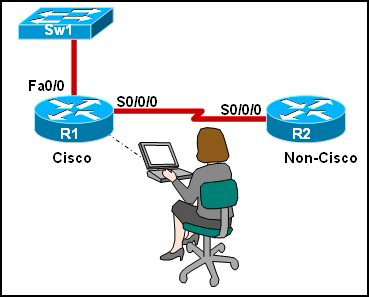
Refer to the exhibit. The network administrator is configuring R1 to connect to R2, which is a non-Cisco router. Which encapsulation method will need to be configured for communication to occur?
• HDLC
• HSSI
• ISDN
• IPCP
• PPP
22. A company is implementing dialup services for remote workers to connect to the local network. The company uses multiple Layer 3 protocols and requires authentication for security. Which protocol should be used for this remote access?
• LMI
• PPP
• HDLC
• Frame Relay
23. Which two options can LCP negotiate? (Choose two.)
• compression
• authentication
• dynamic flow control
• network layer address for IP
• connection-oriented or connectionless communication methods
24. What statement best describes cell switching?
• It uses a dedicated path between endpoints.
• It creates a permanent physical link between two points.
• It uses DLCIs to identify virtual circuits.
• It creates fixed-length packets that traverse virtual circuits.
1. 
Refer to the exhibit. What statement describes the DR/BDR relationship of the HQ router?
• HQ is the DR.
• HQ is the BDR.
• HQ is a DROTHER.
• HQ is a member of an NBMA network.
2. Which two features are associated with Frame Relay OSPF point-to-multipoint environments? (Choose two.)
• A DR is not elected.
• The OSPF priority value determines the active DR on the Frame Relay link.
• OSPF neighbor routers are statically defined.
• The link types are identified as broadcast multiaccess.
• The BDR will have a router ID whose value is greater than the DR router ID.
3. 
Refer to the exhibit. How was the OSPF default gateway entry for R2 determined?
• Default routes are automatically injected by OSPF into all advertisements.
• A static default gateway route is defined in the configuration of R2.
• The default-information originate command is applied on R1.
• The ISP defines the gateway of last resort and automatically passes it to R1 and R2.
• The ip default-gateway command is applied on R2.
4. What is always required for OSPF routers to share routing information?
• designated routers
• a backup designated router
• neighbor adjacencies
• an NBMA network topology
• links that are configured on the 224.0.0.0 network
5. 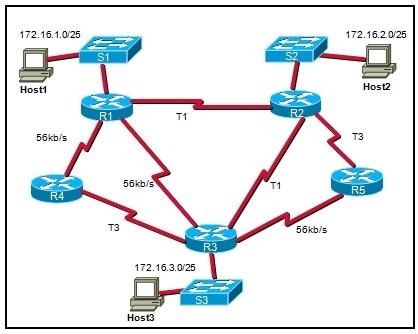
Refer to the exhibit. A network administrator has implemented OSPF and the network has converged. If all router interfaces are enabled and functional, what route will OSPF view as lowest cost when moving frames from Host3 to Host1?
• R3 to R4 to R1
• R3 to R1
• R3 to R2 to R1
• R3 to R5 to R2 to R1
6. 
Refer to the exhibit. Which commands configure router A for OSPF?
• router ospf 1
network 192.168.10.0
• router ospf 1
network 192.168.10.64 0.0.0.63 area 0
network 192.168.10.192 0.0.0.3 area 0
• router ospf 1
network 192.168.10.64 255.255.255.192
network 192.168.10.192 255.255.255.252
• router ospf 1
network 192.168.10.0 area 0
7. 
Refer to the exhibit. Which network statement configures the home router to allow all the interfaces to participate in OSPF?
• network 10.0.0.0 0.3.255.255 area 0
• network 10.8.0.0 0.0.0.3 area 0
• network 10.8.0.0 0.3.255.255 area 0
• network 10.10.0.0 0.0.0.3 area 0
• network 10.12.0.0 0.3.255.255 area 0
8. Which statement is true regarding OSPF DR and BDR elections?
• A new DR/BDR election occurs each time a new OSPF neighbor is added.
• The router with the highest OSPF priority setting wins the election for DR.
• The default priority value for a router connected to a multi-access network is 0.
• The router with the highest MAC address is elected as the DR when the default priority values are used.
9. 
Refer to the exhibit. The network administrator would like only the 172.16.32.0 network advertised to Router1. Which OSPF network command accomplishes this?
• Router2(config-router)# network 172.16.0.0 0.0.0.15 area 0
• Router2(config-router)# network 172.16.0.0 0.0.15.255 area 0
• Router2(config-router)# network 172.16.32.0 0.0.15.255 area 0
• Router2(config-router)# network 172.16.32.0 0.0.255.255 area 0
10. Which two statements describe the operation of link-state routing protocols? (Choose two.)
• All routers in the same area have identical link-state databases when converged.
• Routing loops are prevented by running the Diffusing Update Algorithm (DUAL).
• Link-state routers send frequent periodic updates of the entire routing table.
• Reliable Transport Protocol (RTP) is used to deliver and receive LSAs.
• Calculating the shortest path for each destination is accomplished with the SPF algorithm.
11. 
Refer to the exhibit. Routers A, B, and C are part of the existing OSPF network. Router D has been added to the network. All routers are running OSPF and have the indicated priorities applied to the interface. What is the DR/BDR status immediately after router D is added to the existing network?
• An election is forced and router D wins the DR election.
• The DR and BDR do not change until the next election.
• An election is forced and the existing BDR becomes the DR.
• The router with the highest router ID becomes the new BDR.
12. Which two statements describe the use of OSPF DR/BDR elections? (Choose two.)
• Elections are always optional.
• Elections are required in all WAN networks.
• Elections are required in point-to-point networks.
• Elections are required in broadcast multiaccess networks.
• Elections are sometimes required in NBMA networks.
13. 
Refer to the exhibit. As part of an OSPF network, R1 and R2 are trying to become adjacent neighbors. Although it appears that the two systems are communicating, neither of the routing tables include OSPF routes received from its neighbor. What could be responsible for this situation?
• R1 and R2 are not on the same subnet.
• The Process IDs on each router do not match.
• The timer intervals on the routers do not match.
• The value set for the Transmit Delay time on both routers is too low.
14. 
Refer to the exhibit. What is the purpose of the value 128 shown in bold?
• It is the OSPF cost metric.
• It is the OSPF administrative distance.
• It is the value assigned by the Dijkstra algorithm that designates the distance in hops to the network.
• It is the value assigned to an interface that is used by the DUAL algorithm to determine the metric.
15. 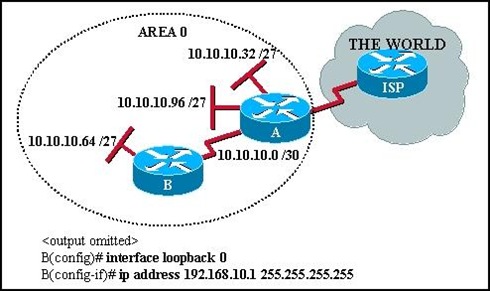
Refer to the exhibit. What is the purpose of the configuration commands added on router B?
• allows router A to form an adjacency with router B
• provides a stable OSPF router ID on router B
• provides a method of testing router traffic
• creates the OSPF adjacency table on router B
16. 
Refer to the exhibit. The command ip route 10.16.1.64 255.255.255.252 s0/0/0 is entered into the router. Why does network 10.16.1.64/30 appear in the routing table in addition to network 10.16.1.64/27?
• The router views 10.16.1.64/30 and 10.16.1.64/27 as two different networks.
• The static route is used as a backup route for packets destined for 10.16.1.64/27.
• The AD for static routes is lower than the AD for OSPF routes.
• The static route metric is lower than the OSPF metric for the 10.16.1.64/27 network.
17. What is the primary difference between link-state protocols and distance vector protocols with regard to route calculation?
• Distance vector protocols take existing routes from their neighbors and add to them. Link-state protocols independently calculate full routes.
• Link-state protocols calculate and pass full routing tables to all routers in their associated areas, and distance vector protocols do not.
• When determining invalid routes, link-state protocols use split horizon for all route computations. Distance vector protocols use reverse poisoning.
• Distance vector protocols require more CPU and RAM for route calculations than link-state protocols require.
18. What range of networks are advertised in the OSPF updates by the command Router1(config-router)# network 192.168.0.0 0.0.15.255 area 0?
• 192.168.0.0/24 through 192.168.0.15/24
• 192.168.0.0/24 through 192.168.15.0/24
• 192.168.15.0/24 through 192.168.31.0/24
• 192.168.15.0/24 through 192.168.255.0/24
• 192.168.16.0/24 through 192.168.255.0/24
19. 
Refer to the exhibit. When establishing adjacency relationships, which IP address would router A use to send hello packets to router B?
• 10.11.0.1
• 10.11.0.2
• 10.11.0.255
• 224.0.0.5
• 255.255.255.255
20. 
Refer to the exhibit. Which router will be elected the DR and which will become the BDR?
• R1 will be DR and R2 will be BDR.
• R1 will be DR and R3 will be BDR.
• R2 will be DR and R1 will be BDR.
• R2 will be DR and R3 will be BDR.
• R3 will be DR and R2 will be BDR.
• R3 will be DR and R1 will be BDR.
21. When compared to a distance vector routing protocol, what is a benefit of the hierarchical design approach that is used in large OSPF networks?
• simpler configuration
• reduction of router processing requirements
• isolation of network instability
• less complex network planning
22. What are two advantages of using a link-state routing protocol instead of a distance vector routing protocol? (Choose two.)
• The topology database eliminates the need for a routing table.
• Frequent periodic updates are sent to minimize the number of incorrect routes in the topological database.
• Routers have direct knowledge of all links in the network and how they are connected.
• After the initial LSA flooding, routers generally require less bandwidth to communicate changes in a topology.
• A link-state routing protocol requires less router processor power.
23. If a network has converged, what is true about the link-state database held by each router in the same OSPF area?
• Each router has a link-state database containing the same status information.
• Each router has a different link-state database depending on its position within the network.
• The link-state database is stored in a designated router and is accessed by each router in the area as needed.
• The link-state database in each router only contains information about adjacent routers and the status of their links.
24. 
Refer to the exhibit. RTRC was recently configured and is not sending the proper OSPF routes to RTRB, as shown in the RTRB routing table. Based on the RTRC configuration, what is most likely the problem?
• RTRC interfaces are administratively shut down.
• The OSPF process ID for RTRC does not match the process ID used on RTRB.
• The interface addresses on RTRC overlap with other addresses in the network.
• The OSPF routing configuration on RTRC has a missing or incorrect network statement.
1. What three statements are true about routers that are configured for EIGRP? (Choose three.)
• They can support multiple routed protocols
• They can support only link-state protocols.
• They send their entire routing tables to neighboring routers.
• They send partial routing updates in response to topology changes.
• They send routing updates to all other routers in the network.
• They use hello packets to inform neighboring routers of their status.
2. Given the following commands:
Router(config)# router rip
Router(config-router)# network 192.31.7.0
What three conclusions can be determined based on the commands used on the router? (Choose three.)
• A link-state routing protocol is used.
• A distance vector routing protocol is used.
• Routing updates broadcast every 30 seconds.
• Routing updates broadcast every 90 seconds.
• Hop count is the only metric used for route selection.
• Bandwidth, load, delay, and reliability are metrics used for route selection.
3. What is indicated when an EIGRP route is in the passive state?
• The route has the highest path cost of all routes to that destination network.
• The route must be confirmed by neighboring routers before it is put in the active state.
• The route is a feasible successor and will be used if the active route fails.
• There is no activity on the route to that network.
• The route is viable and can be used to forward traffic.
4. What two problems may occur if the EIGRP default bandwidth for a serial link is higher than the actual bandwidth? (Choose two.)
• Routing updates will arrive too quickly for receiving routers to process.
• The port IP address will be rejected by the routing protocol.
• Suboptimal paths will be selected.
• The port protocol will return to the HDLC default.
• VLSM support will be disabled.
• Network convergence may be affected.
5. What is the default administrative distance for EIGRP internal routes?
• 70
• 90
• 100
• 110
• 120
• 255
6. A network administrator issues the command show ip route and sees this line of output:
192.168.3.0/24 [120/2] via 192.168.2.2, 00:00:05, Serial0/0
What two pieces of information can be obtained from the output? (Choose two.)
• RIP is the routing protocol configured.
• This is a static route to network 192.168.3.0.
• The metric for this route is 2.
• The next periodic update is in 5 seconds.
• The autonomous system number is 120.
7. 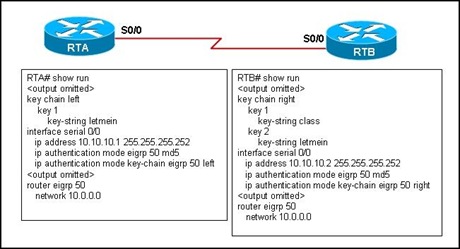
Refer to the exhibit. Which statement is true about the EIGRP authentication configuration?
• RTA and RTB will accept updates from each other.
• RTA and RTB will not accept updates from each other because key 1 on RTB does not match RTA.
• RTA and RTB will not accept updates from each other because the key chain names do not match.
• The ip authentication mode AS does not match the locally configured AS.
8. Which Layer 4 protocol does EIGRP use to provide reliability for the transmission of routing information?
• DUAL
• IP
• PDM
• RTP
• TCP
• UDP
9. 
Refer to the exhibit. Routers RTR-1 and RTR-3 are completely configured. The administrator needs to configure the routing protocol on router RTR-2 so that communication occurs throughout the network. Which group of commands will successfully configure EIGRP on RTR-2?
• RTR-2(config)# router eigrp 1
RTR-2(config-router)# network 198.18.76.0
• RTR-2(config)# router eigrp 1
RTR-2(config-router)# network 198.18.76.0 0.0.0.3 no-summary
RTR-2(config-router)# network 198.18.76.4 0.0.0.3 no-summary
RTR-2(config-router)# network 198.18.76.128 0.0.0.192 no-summary
• RTR-2(config)# router eigrp 1
RTR-2(config-router)# network 198.18.76.0 0.0.0.3 area 0
RTR-2(config-router)# network 198.18.76.4 0.0.0.3 area 0
RTR-2(config-router)# network 198.18.76.192 0.0.0.192 area 0
• RTR-2(config)# router eigrp 1
RTR-2(config-router)# network 198.18.76.0 0.0.0.3
RTR-2(config-router)# network 198.198.76.4 0.0.0.3
RTR-2(config-router)# network 198.198.76.128 0.0.0.192
10. What prevents RIPv1 updates from being correctly advertised?
• an increase in network load
• the use of variable length subnet masks
• the use of multiple Layer 3 networks on the same router
• a variation in connection speeds on the links to a destination
• a mismatch between the configured bandwidth and the actual bandwidth of a link
11. What does a router that is running RIP use to determine the best path to take when forwarding data?
• the host portion of the network address
• the speed of network convergence
• the calculated metric for the destination network
• the number of broadcasts occurring on an interface
• the number of errors occurring on an interface
12. What is the purpose of the network command when RIP is being configured as the routing protocol?
• It identifies the networks connected to the neighboring router.
• It restricts networks from being used for static routes.
• It identifies all of the destination networks that the router is allowed to install in its routing table.
• It identifies the directly connected networks that will be included in the RIP routing updates.
13. How do EIGRP routers establish and maintain neighbor relationships?
• by exchanging neighbor tables with directly attached routers
• by comparing known routes to information received in updates
• by exchanging hello packets with neighboring routers
• by dynamically learning new routes from neighbors
• by exchanging routing tables with directly attached routers
14. 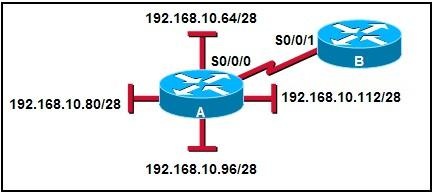
Refer to the exhibit. Routers A and B have EIGRP configured and automatic summarization has been disabled on both routers. Which router command will summarize the attached routes?
• ip area-range eigrp 1 192.168.10.80 255.255.255.224
• ip summary-address eigrp 1 192.168.10.64 255.255.255.192
• ip summary-address 192.168.10.80 0.0.0.31
• ip summary-address eigrp 1 192.168.10.64 0.0.0.63
• ip area-range eigrp 1 192.168.10.64 255.255.255.224
15. How often does RIPv2 send routing table updates, by default?
• every 30 seconds
• every 45 seconds
• every 60 seconds
• every 90 seconds
16. 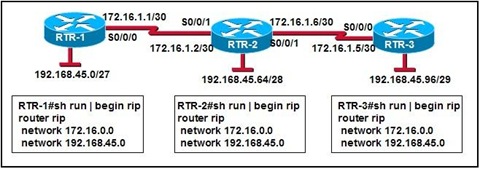
Refer to the exhibit. A network administrator is troubleshooting a routing problem. When the show ip route command is entered on RTR-1, only the serial link between RTR-2 and RTR-3 has been learned from the RIP routing protocol. What are two issues? (Choose two.)
• RIPv1 is a classful routing protocol.
• RIPv1 does not support subnetting.
• The Ethernet networks on RTR-2 and RTR-3 were not entered correctly in the network statements on these routers.
• RIPv1 does not support VLSM.
• RIPv1 is a classless routing protocol.
17. What two statements are correct regarding EIGRP authentication? (Choose two.)
• EIGRP authentication uses the MD5 algorithm.
• EIGRP authentication uses a pre-shared key.
• EIGRP authentication requires that both routers have the same key chain name.
• EIGRP authentication uses varying levels of WEP to encrypt data exchanged between routers.
• EIGRP authentication can be configured on one router and updates from this router are protected; whereas a neighbor router can be without the authentication configuration and its updates are unprotected.
18. When should EIGRP automatic summarization be turned off?
• when a router has not discovered a neighbor within three minutes
• when a router has more than three active interfaces
• when a network contains discontiguous network addresses
• when a router has less than five active interfaces
• when a network addressing scheme uses VLSM
19. What is the maximum number of hops that RIP will attempt before it considers the destination unreachable?
• 14 hops
• 15 hops
• 16 hops
• 17 hops
20. What two statements are true regarding EIGRP tables? (Choose two.)
• A feasible successor route can be found in the topology table.
• A successor route can only be found in the routing table.
• The topology table shows whether a route is in the passive or active state.
• The routing table shows the amount of time elapsed since a router adjacency was formed.
• The neighbor table shows all adjacent Cisco devices.
• Administrative distance is shown as a column in the neighbor table.
21. 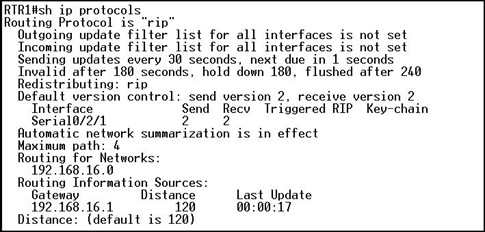
Refer to the exhibit. Which statement is true about the output from the show ip protocols command?
• RIPv2 is configured on this router.
• Auto summarization has been disabled.
• The next routing update is due in 17 seconds.
• 192.168.16.1 is the address configured on the local router
1. In an 8 bit binary number, what is the total number of combinations of the eight bits?
• 128
• 254
• 255
• 256
• 512
• 1024
2. Convert the decimal number 231 into its binary equivalent. Select the correct answer from the list below.
• 11110010
• 11011011
• 11110110
• 11100111
• 11100101
• 11101110
3. How many usable hosts are available given a Class C IP address with the default subnet mask?
• 254
• 255
• 256
• 510
• 511
• 512
4. Which statement describes NAT overload or PAT?
• Each internal address is dynamically translated to an individual external IP address.
• A single internal address is always translated to the same unique external IP address.
• Many internal addresses can be translated to a single IP address using different port assignments.
• Many internal addresses are statically assigned a single IP address and port to use for communications.
5. Which IPv4 class of addresses provides the most networks?
• Class A
• Class B
• Class C
• Class D
• Class E
6. Which statement accurately describes public IP addresses?
• Public addresses cannot be used within a private network.
• Public IP addresses must be unique across the entire Internet.
• Public addresses can be duplicated only within a local network.
• Public IP addresses are only required to be unique within the local network.
• Network administrators are free to select any public addresses to use for network devices that access the Internet.
7. Which two statements describe classful IP addresses? (Choose two.)
• It is possible to determine which class an address belongs to by reading the first bit.
• The number of bits used to identify the hosts is fixed by the class of the network.
• Only Class A addresses can be represented by high-order bits 100.
• Up to 24 bits can make up the host portion of a Class C address.
• Up to 24 bits can be used to identify unique networks.
• Three of the five classes of addresses are reserved for multicasts and experimental use.
8. Company XYZ uses a network address of 192.168.4.0. It uses the mask of 255.255.255.224 to create subnets. What is the maximum number of usable hosts in each subnet?
• 6
• 14
• 30
• 62
9. hat is the network broadcast address for a Class C address of 192.168.32.0 with the default subnet mask?
• 192.168.0.0
• 192.168.0.255
• 192.168.32.0
• 192.168.32.254
• 192.168.32.255
10. 
Refer to the exhibit. Host A is connected to the LAN, but it cannot get access to any resources on the Internet. The configuration of the host is shown in the exhibit. What could be the cause of the problem?
• The host subnet mask is incorrect.
• The default gateway is a network address.
• The default gateway is a broadcast address.
• The default gateway is on a different subnet from the host.
11. IPv6 increases the IP address size from 32 bits to how many bits?
• 64
• 96
• 128
• 192
• 256
• 512
12. What is the range of the first octet in a Class B address?
• 127 to 191
• 127 to 192
• 128 to 191
• 128 to 192
13. Which IPv4 class provides the highest number of host addresses per network?
• Class A
• Class B
• Class C
• Class D
• Class E
14. 
refer to the exhibit. Which range of IP addresses would allow hosts that are connected to the Router1 Fa0/0 interface to access outside networks?
• 192.168.1.0 through 192.168.1.95
• 192.168.1.66 through 192.168.1.94
• 192.168.1.66 through 192.168.1.96
• 192.168.1.0 through 192.168.1.127
• 192.168.1.66 through 192.168.1.128
15. Which option shows the proper notation for an IPv6 address?
• 2001,0db8,3c55,0015,abcd,ff13
• 2001-0db8-3c55-0015-abcd-ff13
• 2001.0db8.3c55.0015.abcd.ff13
• 2001:0db8:3c55:0015::abcd:ff13
16. What are two reasons that NAT was developed? (Choose two.)
• to preserve registered public IP addresses
• to allow users on the public Internet to access local networks
• to provide a method for privately addressed LANs to participate in the Internet
• to make routing protocols operate more efficiently
• to allow private addresses to be routed on the public Internet
• to reduce overhead and CPU usage on gateway routers
17. What must happen for a privately addressed host on an inside local network to be able to communicate with an outside destination host on the Internet?
• The host IP address must be translated to an outside private address.
• The host IP address must be translated to an inside local address.
• The host IP address must be translated to an outside local address.
• The host IP address must be translated to an inside global address.
18. Which port numbers are used by PAT to create unique global addresses?
• 255 and below
• 1024 and below
• 1025 and above
• 64,000 and above
19. Static NAT works by mapping a specific inside local IP address to what other specific address type?
• inside global
• outside local
• outside global
• private IP address
20. What are three advantages of NAT implementations? (Choose three.)
• improved security
• improved router performance
• decreased processor load
• improved scalability
• universal application compatibility
• sharing few public IP addresses with many hosts
1. Which two benefits can be gained by locating network equipment in a telecommunications closet, rather than in a user area? (Choose two.)
• faster communication speeds
• improved physical security
• more resistant to hacker attempts
• centralized cable management
• less electrical usage
2. Which three issues should be noted on the technician's site survey report? (Choose three.)
• unlabeled cables
• only two power outlets per wall in each room
• poor physical security of network devices
• horizontal cabling runs under 100 meters
• lack of UPS for critical devices
• two users sharing the same computer
3. Which two types of cable are used for initial router configuration? (Choose two.)
• serial cable
• rollover cable
• straight-through cable
• crossover cable
• patch cable
• console cable
4. In addition to the inventory sheet, what other information about the hosts and networking equipment should be documented by the on-site technician while performing the site survey?
• any obsolete office equipment being stored
• all product keys for site license software
• any planned growth anticipated in the near future
• the memory requirements for installed application software
5. 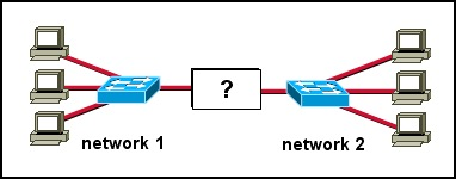
Refer to the exhibit. What type of device is used to connect two networks?
• hub
• router
• switch
• access point
6. It is said that the goal for availability of a communications system is "five-9s". What is meant by this?
• A down time of .00001% is unacceptable.
• A network needs to be available 99.999% of the time.
• Five percent of all network expense covers 99% of user requirements.
• The most critical time for network availability is from 9:00 to 5:00 p.m. five days a week.
• The best time to do maintenance on a network is from 5:00 p.m. to 9:00 a.m. five days a week.
7. What three things are included in a logical topology document? (Choose three.)
• the location of cables, computers, and other peripherals
• the path that the data takes through a network
• the wireless signal coverage area
• the wiring closet and access point locations
• the device names and Layer 3 addressing information
• the location of routing, network address translation, and firewall filtering
8. Which device has the ability to break up broadcast and collision domains?
• repeater
• hub
• router
• switch
9. Why is it important to review the results of an on-site survey report with the customer before beginning the network design?
• to inform the customer of how much time the upgrade will take
• to discuss the implementation schedule for the new equipment
• to verify that the report accurately describes the current network and any plans for expansion
• to layout the new network design and discuss possible equipment upgrades and replacements
10. A client requires a networking device that is capable of expansion to suit growing network demands. What type of device will suit this requirement?
• a networking device with ports that can be activated and deactivated
• a networking device with a modular physical configuration
• a networking device with the ability to be turned off remotely
• a networking device with a cost per port that is as high as possible
11. What does the use of redundant network components supply to a network?
• scalability
• manageability
• compatibility
• reliability
12. What is the benefit for a company to use an ISR router?
• An ISR provides the functionality of a switch, router, and firewall in one device.
• ISRs use a PC operating system for routing traffic, thus simplifying configuration and management.
• An ISR is immune to security attacks by hackers and so replaces all other network security measures.
• ISRs make routing decisions at OSI Layer 7, thus providing more intelligence to the network than do other routers.
13. Which three items are typically found in an MDF? (Choose three.)
• user workstations
• switches and routers
• fax machines
• network equipment racks
• the point of presence
• copier
14. What are two advantages of having ISP-managed services? (Choose two.)
• does not require leasing costs for service
• can guarantee up to 99.999% availability
• eliminates the need for data backup
• increases availability of help desk services
• does not require a Service Level Agreement
15. A manufacturing company is in the process of a network upgrade. Which two statements are true about the phases of the upgrade process? (Choose two.)
• Phase 1 is used to determine network requirements.
• Phase 2 includes creating an analysis report.
• Phase 3 is based on an implementation schedule that allows extra time for unexpected events.
• Phase 4 is where prototypes are created and tested.
• Phase 5 includes identifying and addressing any weaknesses in the design.
16. When designing a network upgrade, which two tasks should the onsite technician perform? (Choose two.)
• configure the servers and routers prior to delivery
• upgrade the network operating system and all client operating systems
• investigate and document the physical layout of the premises
• document the final design for approval by the customer
• perform a site survey to document the existing network structure
17. What is the term for the location at the customer premise where the customer network physically connects to the Internet through a telecommunications service provider?
• backbone area
• point of presence
• network distribution facility
• intermediate distribution frame
18. 
to the exhibit. Which type of twisted pair cable is used between each device?
• A=console, B=straight, C=crossover, D= crossover, E=straight
• A=straight, B=straight, C=straight, D=crossover, E=console
• A=crossover, B=straight, C=straight, D=crossover, E=crossover
• A=console, B=straight, C=straight, D=crossover, E=crossover
• A=console, B=crossover, C=crossover, D=straight, E=straight
19. In what two ways will entering into a managed service agreement with an ISP for a network upgrade affect the costs that are incurred by the customer? (Choose two.)
• Customer IT training costs will increase to enable operation of the new equipment.
• The cost of hardware repairs and support will become the responsibility of the customer.
• Network upgrade and maintenance costs will become predictable.
• Staffing costs will increase because the customer will need to hire additional IT staff to complete the upgrade.
• The company will not need to spend a large amount of money to purchase the equipment upfront.
20. Which type of cable has a solid copper core with several protective layers including PVC, braided wire shielding, and a plastic covering?
• STP
• UTP
• coaxial
• fiber optic
21. What must be added when a network expands beyond the coverage area of the current telecommunications room?
• MDF
• POP
• IDF
• IXP
1. Which two functions are provided by the upper layers of the OSI model? (Choose two.)
• placing electrical signals on the medium for transmission
• initiating the network communication process
• encrypting and compressing data for transmission
• segmenting and identifying data for reassembly at the destination
• choosing the appropriate path for the data to take through the network
2. Which is a function of the transport layer of the OSI model?
• routes data between networks
• converts data to bits for transmission
• delivers data reliably across the network using TCP
• formats and encodes data for transmission
• transmits data to the next directly connected device
3. Which common Layer 1 problem can cause a user to lose connectivity?
• incorrect subnet mask
• incorrect default gateway
• loose network cable
• NIC improperly installed
4. Which three command line utilities are most commonly used to troubleshoot issues at Layer 3? (Choose three.)
• ping
• a packet sniffer
• Telnet
• ipconfig
• Traceroute
5. Which address is used by the router to direct a packet between networks?
• source MAC address
• destination MAC address
• source IP address
• destination IP address
6. What is the correct encapsulation order when data is passed from Layer 1 up to Layer 4 of the OSI model?
• bits, frames, packets, segments
• frames, bits, packets, segments
• packets, frames, segments, bits
• segments, packets, frames, bits
7. What are two goals of the ISP help desk? (Choose two.)
• conserving support resources
• network optimization
• competitive scalability
• customer retention
• sales of network services
8. In what two ways do Level 1 and Level 2 help desk technicians attempt to solve a customer's problems? (Choose three.)
• talking to the customer on the telephone
• upgrading hardware and software
• using various web tools
• making an onsite visit
• installing new equipment
• with remote desktop sharing applications
9. A customer calls the help desk about setting up a new PC and cable modem and being unable to access the Internet. What three questions would the technician ask if the bottom-up troubleshooting approach is used? (Choose three.)
• Is the NIC link light blinking?
• What is the IP address and subnet mask?
• Can the default gateway be successfully pinged?
• Is the network cable properly attached to the modem?
• Is the Category 5 cable properly connected to the network slot on the PC?
• Can you access your e-mail account?
10. A customer calls to report a problem accessing an e-commerce web site. The help desk technician begins troubleshooting using a top-down approach. Which question would the technician ask the customer first?
• Can you access other web sites?
• Is there a firewall installed on your computer?
• What is your IP address?
• Is the link light lit on your NIC card?
11. Which statement describes the process of escalating a help desk trouble ticket?
• The help desk technican resolves the customer problem over the phone and closes the trouble ticket.
• Remote desktop utilities enable the help desk technician to fix a configuration error and close the trouble ticket.
• After trying unsuccessfully to fix a problem, the help desk technician sends the trouble ticket to the onsite support staff.
• When the problem is solved, all information is recorded on the trouble ticket for future reference.
12. What are two functions of the physical layer of the OSI model? (Choose two.)
• adding the hardware address
• converting data to bits
• encapsulating data into frames
• signal generation
• routing packets
13. A customer calls the ISP help desk after setting up a new PC with a cable modem but being unable to access the Internet. After the help desk technician has verified Layer 1 and Layer 2, what are three questions the help desk technician should ask the customer? (Choose three.)
• What is your subnet mask?
• What is your IP address?
• Is the NIC link light blinking?
• Can you ping the default gateway?
• Is the network cable properly attached to the cable modem?
• Is the network cable correctly connected to the network port on the PC?
14. Which scenario represents a problem at Layer 4 of the OSI model?
• An incorrect IP address on the default gateway.
• A bad subnet mask in the host IP configuration.
• A firewall filtering traffic addressed to TCP port 25 on an email server.
• An incorrect DNS server address being given out by DHCP.
15. What are two basic procedures of incident management? (Choose two.)
• opening a trouble ticket
• using diagnostic tools to identify the problem
• surveying network conditions for further analysis
• configuring new equipment and software upgrades
• adhering to a problem-solving strategy
• e-mailing a problem resolution to the customer
16. Which level of support is supplied by an ISP when providing managed services?
• Level 1
• Level 2
• Level 3
• Level 4
17. What is the first step that is used by a help desk technician in a systematic approach to helping a customer solve a problem?
• identify and prioritize alternative solutions
• isolate the cause of the problem
• define the problem
• select an evaluation process
18. A network technician has isolated a problem at the transport layer of the OSI model. Which question would provide further information about the problem?
• Do you have a firewall that is configured on your PC?
• Do you have a link light on your network card?
• Is your PC configured to obtain addressing information using DHCP?
• What default gateway address is configured in your TCP/IP settings?
• Can you ping http://www.cisco.com?
19. An ISP help desk technician receives a call from a customer who reports that no one at their business can reach any websites, or get their e-mail. After testing the communication line and finding everything fine, the technician instructs the customer to run nslookup from the command prompt. What does the technician suspect is causing the customer's problem?
• improper IP address configuration on the host
• hardware failure of the ISR used to connect the customer to the ISP
• bad cables or connections at the customer site
• failure of DNS to resolve names to IP addresses
20. Which layers of the OSI model are commonly referred to as the upper layers?
• application, presentation, session
• application, session, network
• presentation, transport, network
• presentation, network, data link
• session, transport, network